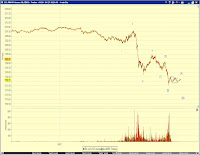Regarding the larger picture, the primary degree rally since last March has either topped (or nearly so, and with diverging tops in large and small caps, after another minute degree advance) OR has one more minor degree advance after the current pullback is complete, DEPENDING ON which wave label – (X) or B – is correct regarding the 2/5/10 low.
Subjectively, I’m sympathetic with expectation of a new rally high before the market tops. With the “nearly topped with diverging tops” interpretation, a target range may be 1235-1245 in SPX; and with the “correction” interpretation, a target range may be 1255-1275. But strategic bears are certainly content if the top is indeed in place. See discussions below.
 Topped – The primary degree rally since last March may have already topped if it takes on the particular triple-three form of zigzag-(X)-zigzag-(X)-flat (Chart 1). The blue labels in Chart 2(SPX) and Chart 3 (RUT) present a detailed count of C of (Z) on the 60-minute chart. Both SPX and RUT sport an expanding diagonal top, which is reportedly rare.
Topped – The primary degree rally since last March may have already topped if it takes on the particular triple-three form of zigzag-(X)-zigzag-(X)-flat (Chart 1). The blue labels in Chart 2(SPX) and Chart 3 (RUT) present a detailed count of C of (Z) on the 60-minute chart. Both SPX and RUT sport an expanding diagonal top, which is reportedly rare.

 In addition to the impulse wave declines over the past few days, the other piece of supporting evidence is that FTSE100 has likely seen its top (Chart 4). See detailed discussions on FTSE100 in A potentially major turning point (4/9/10), Turning (4/16/10), and Targets for a good turn (4/23/10).
In addition to the impulse wave declines over the past few days, the other piece of supporting evidence is that FTSE100 has likely seen its top (Chart 4). See detailed discussions on FTSE100 in A potentially major turning point (4/9/10), Turning (4/16/10), and Targets for a good turn (4/23/10).Nearly topped with diverging tops– The green labels in Chart 2(SPX) and Chart 3 (RUT) present a potential pair of diverging tops in large cap indexes and small cap indexes - a regular [v] of C(Z) in SPX and an expanding diagonal [v] of C(Z) in the RUT - that still require one more minute degree advance before topping. The diverging tops become a necessity at the moment in terms of wave counts as the RUT has already declined below its 4/27 or 4/28 low while SPX has not, so far.
 A correction – If the primary degree rally since last March is a triple zigzag as shown in Chart 5, the current pullback should be just a minor degree B wave of (Z). When B-down of (Z) is complete, a final minor degree C-up of (Z) will push the market to new highs to conclude the primary degree rally.
A correction – If the primary degree rally since last March is a triple zigzag as shown in Chart 5, the current pullback should be just a minor degree B wave of (Z). When B-down of (Z) is complete, a final minor degree C-up of (Z) will push the market to new highs to conclude the primary degree rally.Chart 6(SPX) and Chart 7(RUT) present a detailed count of waves A-up and B-down (to date) of (Z). The correction is NOT yet over (in time and most likely in price as well) under this interpretation. Expect SPX to decline to 1150-1170 area before finding support.


*****Appendix
Regarding the near term price actions, the 4/28/10 low could hold in SPX and INDU, but not in RUT (which has already dropped below it) and COMP (which has suffered extremely deep retracement).











































